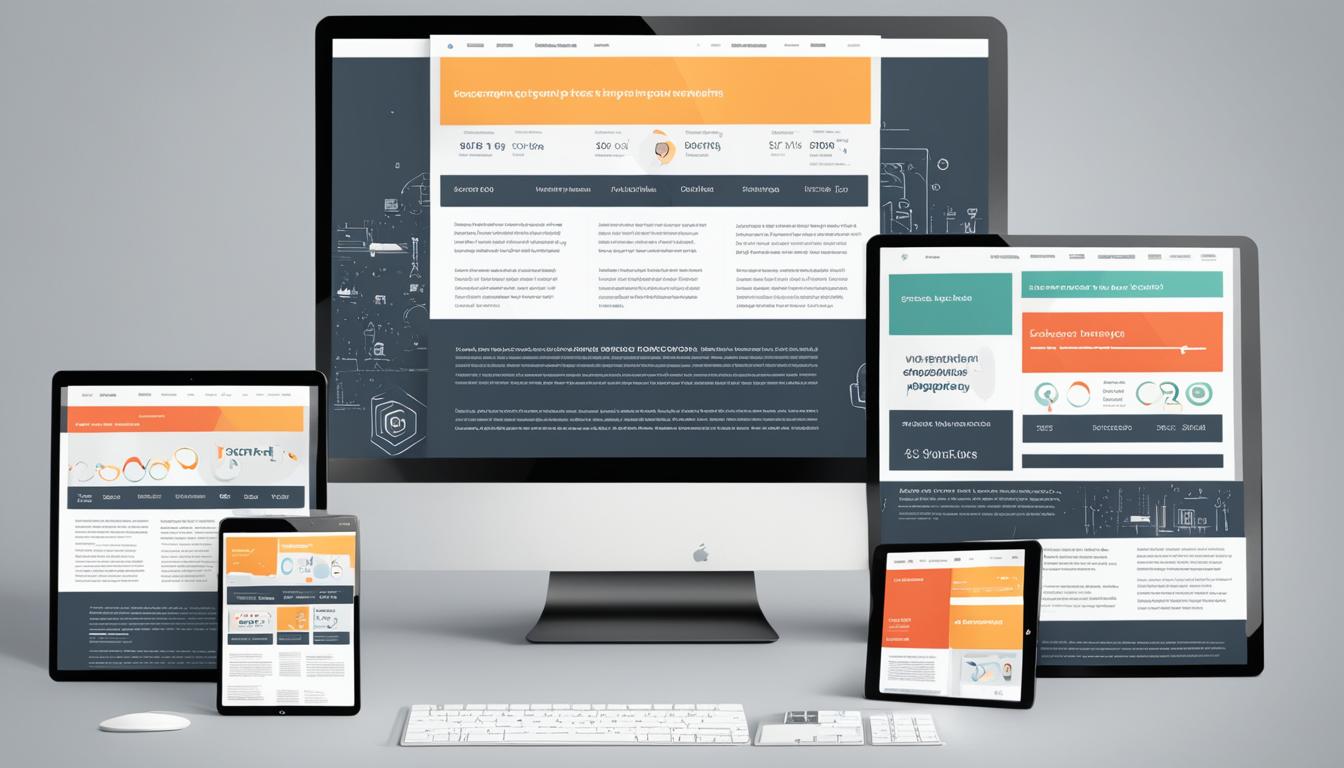When it comes to SEO, using responsive images is a game-changer. As a website owner or digital marketer, you know the importance of optimizing your site for search engines and providing a seamless user experience. Responsive images allow you to achieve both goals simultaneously. By adapting to different screen sizes and resolutions, responsive images ensure that your website looks stunning and loads quickly on any device, from smartphones to large desktop monitors.
In this section, I will delve into the strategies and best practices for leveraging responsive images to boost your SEO efforts. You will learn how responsive images contribute to a mobile-friendly website, enhance page loading times, and improve overall user engagement. By implementing these image optimization techniques, you can increase your chances of ranking higher in search engine results and drive more organic traffic to your site.
Key Takeaways:
- Responsive images play a crucial role in optimizing your website for SEO.
- They adapt to different screen sizes and resolutions, ensuring a seamless user experience.
- Optimizing images improves page loading times and overall website performance.
- A mobile-friendly website design is a vital ranking factor in search engine algorithms.
- By following best practices, such as using HTML image elements and optimizing alt text, you can maximize image SEO.
The Importance of Responsive Images in SEO
Responsive images are a critical component of effective SEO strategies. They play a significant role in creating a mobile-friendly website design, which is crucial for ranking high on search engine results pages (SERPs). By optimizing images for various screen sizes and resolutions, you ensure that your website loads quickly and appears correctly across all devices, leading to a seamless user experience.
In addition to enhancing user experience, responsive images contribute to the overall performance of your website. When your site is optimized for mobile devices, search engines recognize its mobile-friendliness and prioritize it in SERPs. This can result in higher visibility and increased organic traffic to your website.
One of the primary factors that determine a website’s mobile-friendliness is its responsive web design. By incorporating responsive images into your website, you align with this crucial web design approach, making your site accessible and visually appealing to visitors on different devices.
Moreover, responsive images enable search engines to better understand the content of your images through proper optimization techniques. By providing relevant alt text and descriptive filenames, you enhance the accessibility and SEO value of your images, thereby improving your website’s overall search engine ranking.
By now, it should be clear that responsive images are an essential aspect of successful SEO strategies. They contribute to a mobile-friendly website design, improve user experience, and boost search engine rankings. In the next section, we will dive deeper into best practices for optimizing responsive images, ensuring that you can utilize them effectively to enhance your website’s SEO performance.
Best Practices for Optimizing Responsive Images

When it comes to optimizing your responsive images for SEO, there are several best practices to keep in mind. By following these techniques, you can ensure that your images are not only visually appealing but also contribute to the overall success of your website’s SEO efforts.
-
Use HTML image elements: tag. This allows search engine crawlers to easily find and process your images, improving their visibility in search results.
-
Utilize an image sitemap: Consider creating an image sitemap to help search engines discover and index your images. This can improve the visibility of your images in image search results.
-
Optimize for different screen sizes: To ensure your images look their best on all devices, use the srcset attribute or the element to specify different versions of the same image for different screen sizes. This adaptive image technique enables responsive web design, providing a seamless user experience.
-
Choose supported image formats: It’s important to use image formats that are supported by all devices and browsers. Common supported formats include BMP, GIF, JPEG, PNG, WebP, and SVG. Additionally, make sure that the filename matches the file type to avoid any confusion.
By implementing these image optimization techniques and adopting responsive web design principles, you can enhance your website’s performance, improve user experience, and boost its search engine visibility. Follow these best practices to take full advantage of the power of responsive images and optimize your website for SEO.
“Optimizing your images for different devices and utilizing supported image formats are crucial steps in achieving a mobile-friendly website design and enhancing its visibility in search engine results.”
| Best Practices for Optimizing Responsive Images | Benefits |
|---|---|
| Use HTML image elements | Improved visibility in search results |
| Utilize an image sitemap | Enhanced discovery and indexing by search engines |
| Optimize for different screen sizes | Seamless user experience on all devices |
| Choose supported image formats | Compatibility with all devices and browsers |
Optimizing Image Landing Pages for SEO

When it comes to SEO, optimizing your image landing pages is crucial for improving your website’s visibility and driving organic traffic. By paying attention to various elements such as page titles, descriptions, structured data, alt text, and filenames, you can enhance the overall image SEO and boost your search engine rankings.
Optimize Your Page Titles and Descriptions
The page titles and descriptions of your image landing pages should accurately reflect the content and context of the images. Use descriptive and relevant keywords to ensure search engines understand what the image is about. This will help improve the visibility of your images in search results and increase the likelihood of attracting relevant organic traffic.
Add Structured Data to Your Image Landing Pages
Consider incorporating structured data markup on your image landing pages. By implementing Schema.org markup, you provide search engines with additional information about your images, such as the subject matter, location, and other relevant details. This can enhance the display of your images in search results, making them more appealing to users.
Pay Attention to Image Filenames, Alt Text, and Captions
When optimizing your image landing pages, it’s essential to optimize the filenames, alt text, and captions of your images. Use descriptive filenames that accurately represent the image content and include relevant keywords. Additionally, craft informative and concise alt text that describes the image for users who cannot see it. Avoid keyword stuffing and focus on providing meaningful descriptions.
Optimize Alt Text with Descriptive and Relevant Keywords
Alt text plays a vital role in image SEO by providing textual context to search engines. It’s important to optimize alt text by using descriptive and relevant keywords that accurately represent the image. However, avoid overusing keywords or engaging in keyword stuffing, as this can negatively impact your SEO efforts.
By implementing these optimization techniques on your image landing pages, you can improve the visibility and ranking of your images in search results. This, in turn, can drive more organic traffic to your website and enhance the overall user experience.
Finding and Using the Right Images for SEO

When it comes to optimizing your website’s SEO, finding and using the right images is crucial. Generic stock photos won’t cut it anymore – you need original, relevant images that capture the essence of your content and engage your audience. But where can you find these images? Here are some top image sources:
- Flickr: Creative Commons – This platform offers a wide variety of high-quality, copyright-free images contributed by talented photographers from around the world. Browse through the vast collection and discover captivating visuals that align with your website’s theme.
- Unsplash – Another fantastic resource for finding visually stunning images without copyright restrictions. Unsplash hosts a library of professional photos that can add that extra touch of authenticity to your website.
Now that you have found the perfect images for your website, it’s time to optimize them for SEO. Here are some image optimization tips:
- File Names: Before uploading your images, rename them with descriptive titles that include relevant keywords. This helps search engines understand the content of the image.
- Formats: Choose the appropriate image format for your needs. JPEG is great for photographs, while PNG is ideal for graphics and illustrations.
- Sizes: Resize and compress your images to ensure faster loading times. Large images can slow down your website and negatively impact user experience.
Remember, visually appealing and well-optimized images can significantly enhance your website’s SEO. Take the time to find the right images, optimize them for search engines, and watch your website’s visibility soar.
Why Optimize Images?
“Images are a powerful tool for enhancing user experience and improving SEO. By finding and using the right images, you can captivate your audience and boost your website’s search engine visibility.”
Conclusion
In conclusion, using responsive images is crucial for optimizing your website’s SEO. By incorporating image optimization techniques and following best practices, you can greatly improve the user experience, enhance website performance, and elevate your chances of ranking higher in search engine results.
When implementing responsive images, it is essential to focus on selecting the right images that resonate with your content. Additionally, ensure that these images are optimized for different screen sizes and resolutions, allowing them to adapt seamlessly across devices.
To maximize the impact of responsive images on your SEO strategies, be sure to provide relevant metadata for your images. This includes adding concise and descriptive alt text, captions, and appropriately naming the image files. By doing so, search engines can better understand the context and relevance of your images, further boosting your website’s SEO.
With the power of responsive images, you can take your SEO efforts to new heights. By considering the user experience, optimizing your images, and following industry best practices, you can create a visually appealing and mobile-friendly website that not only delights your users but also gains visibility on search engine results pages.










